Charles E W Bean, Diaries, AWM38 3DRL 606/254/1 - 1917 - 1933 - Part 20

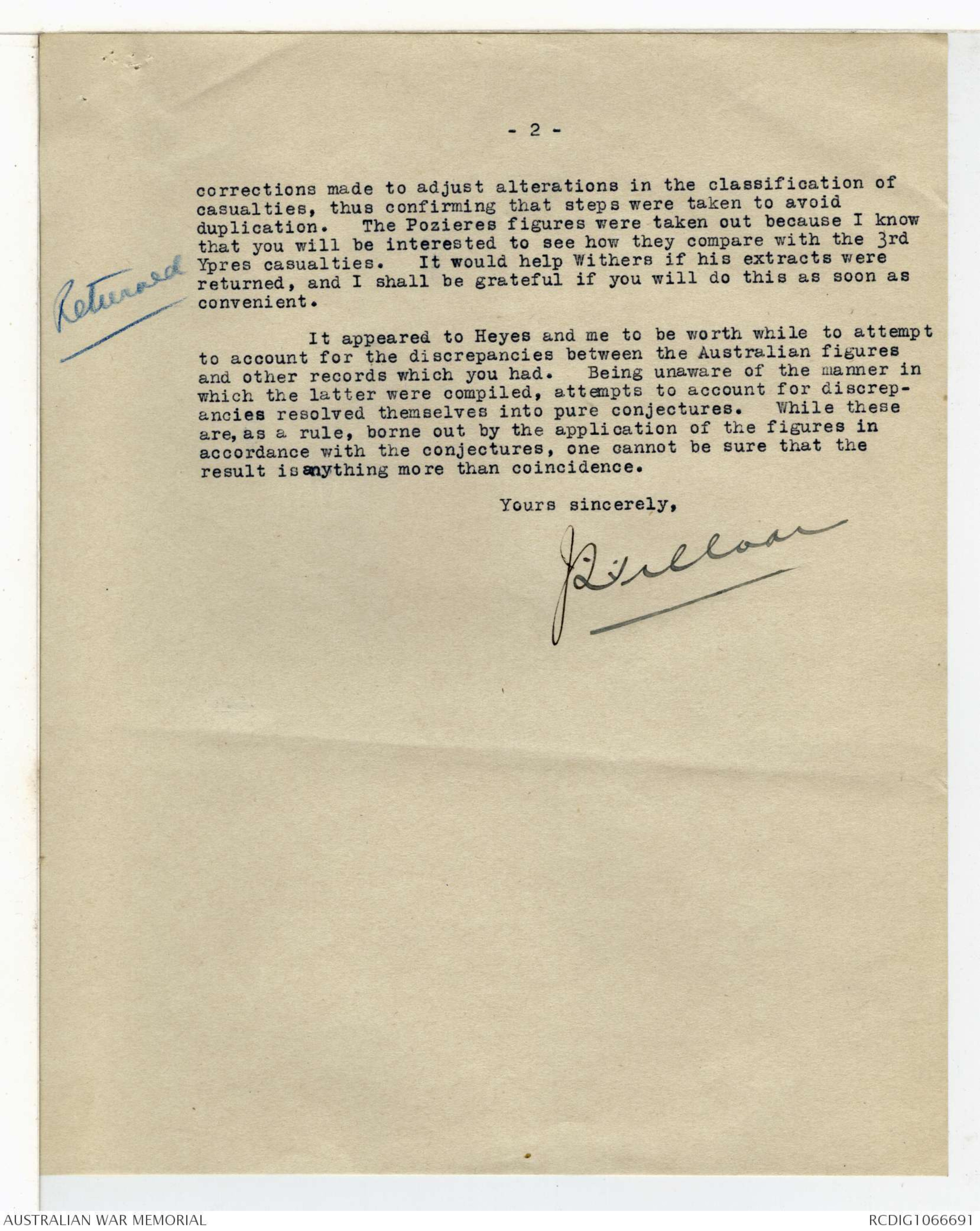
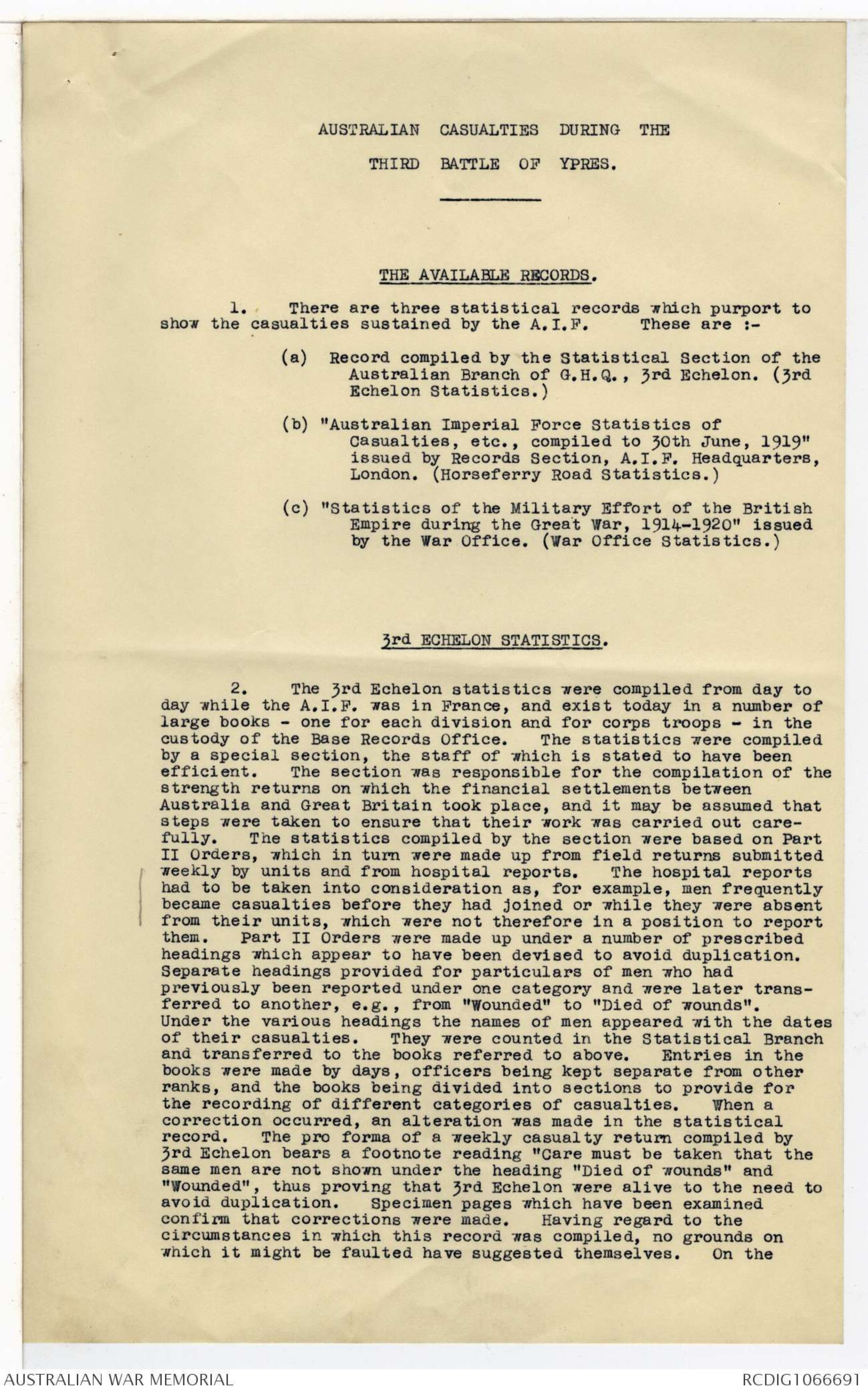

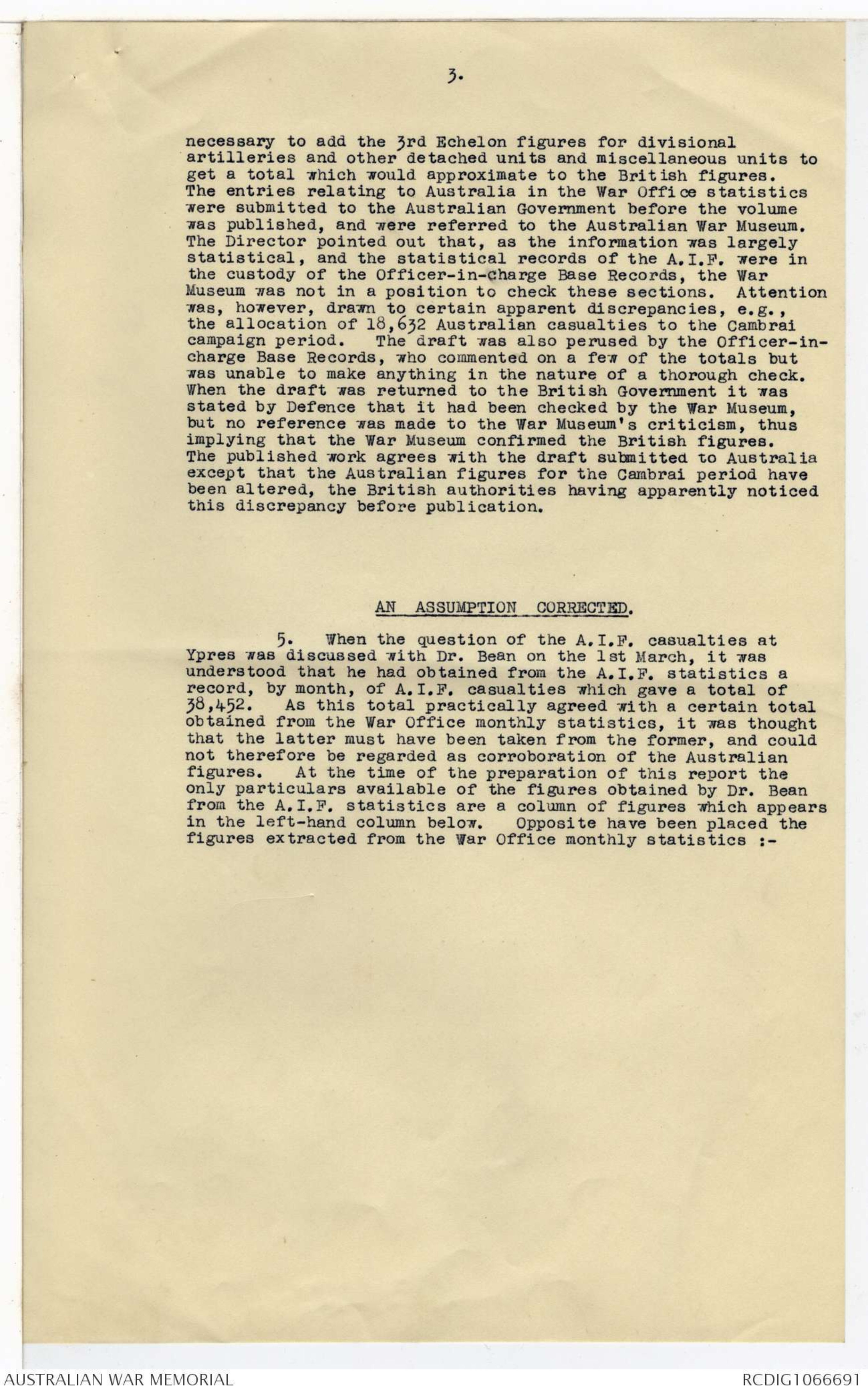
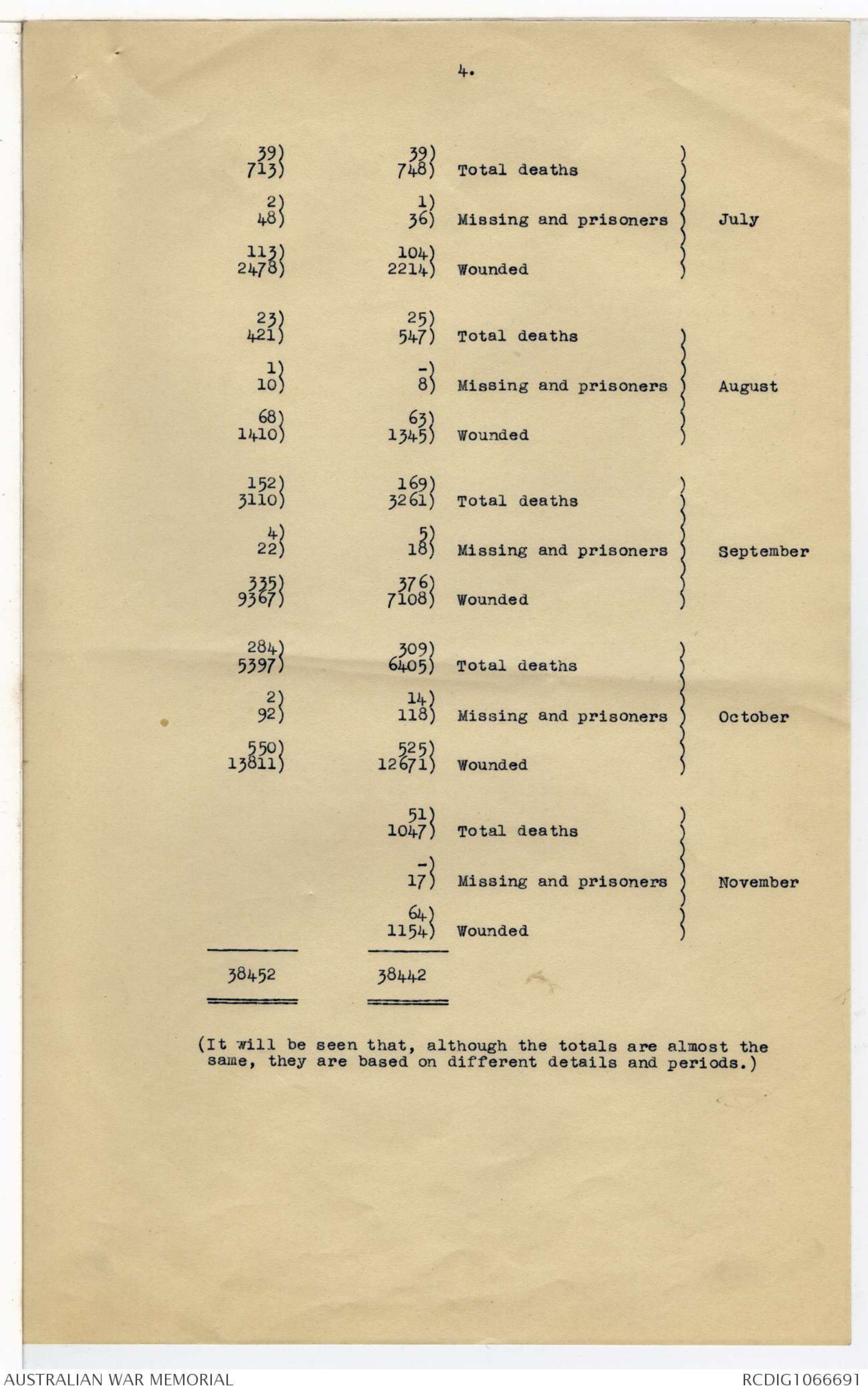
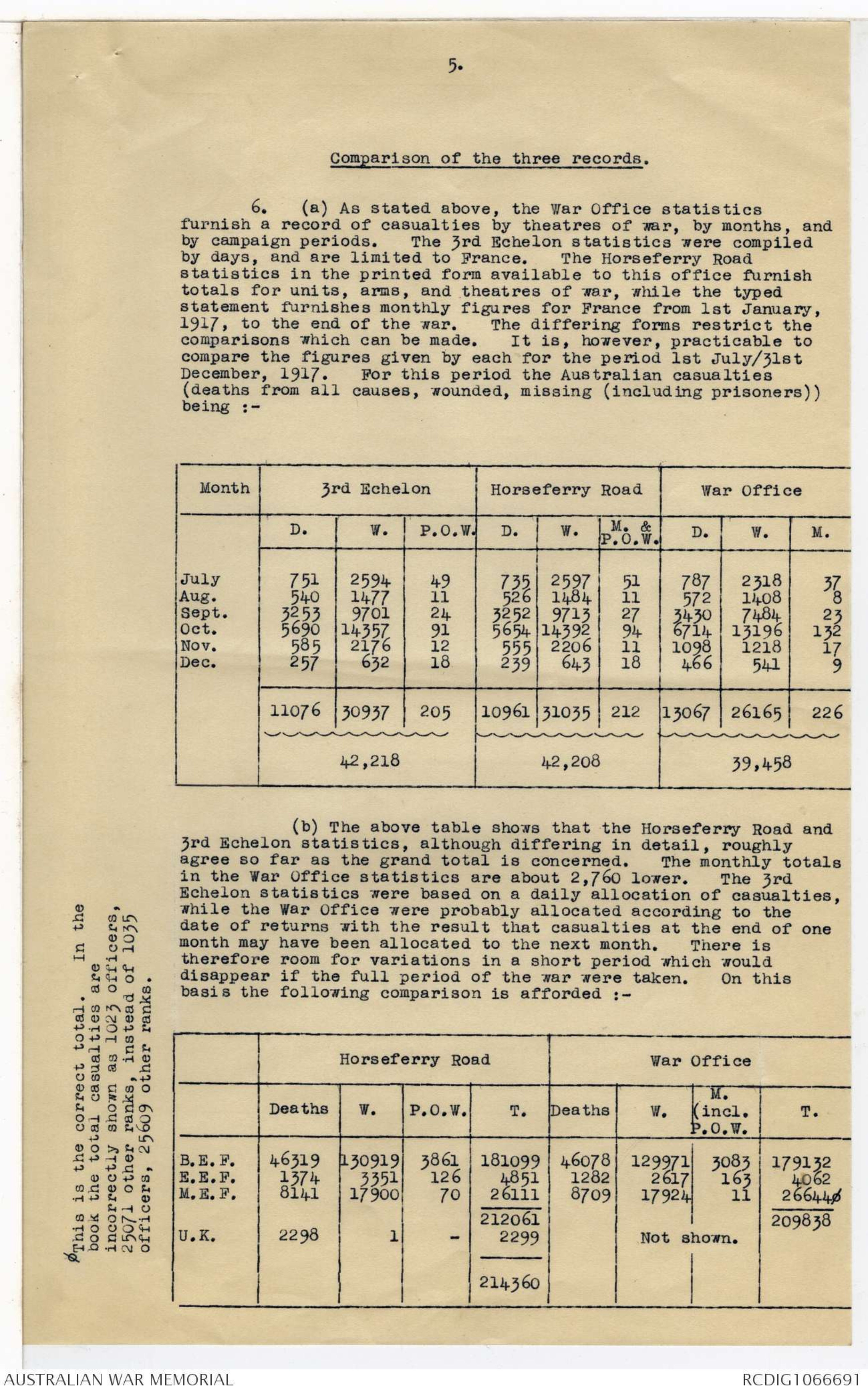
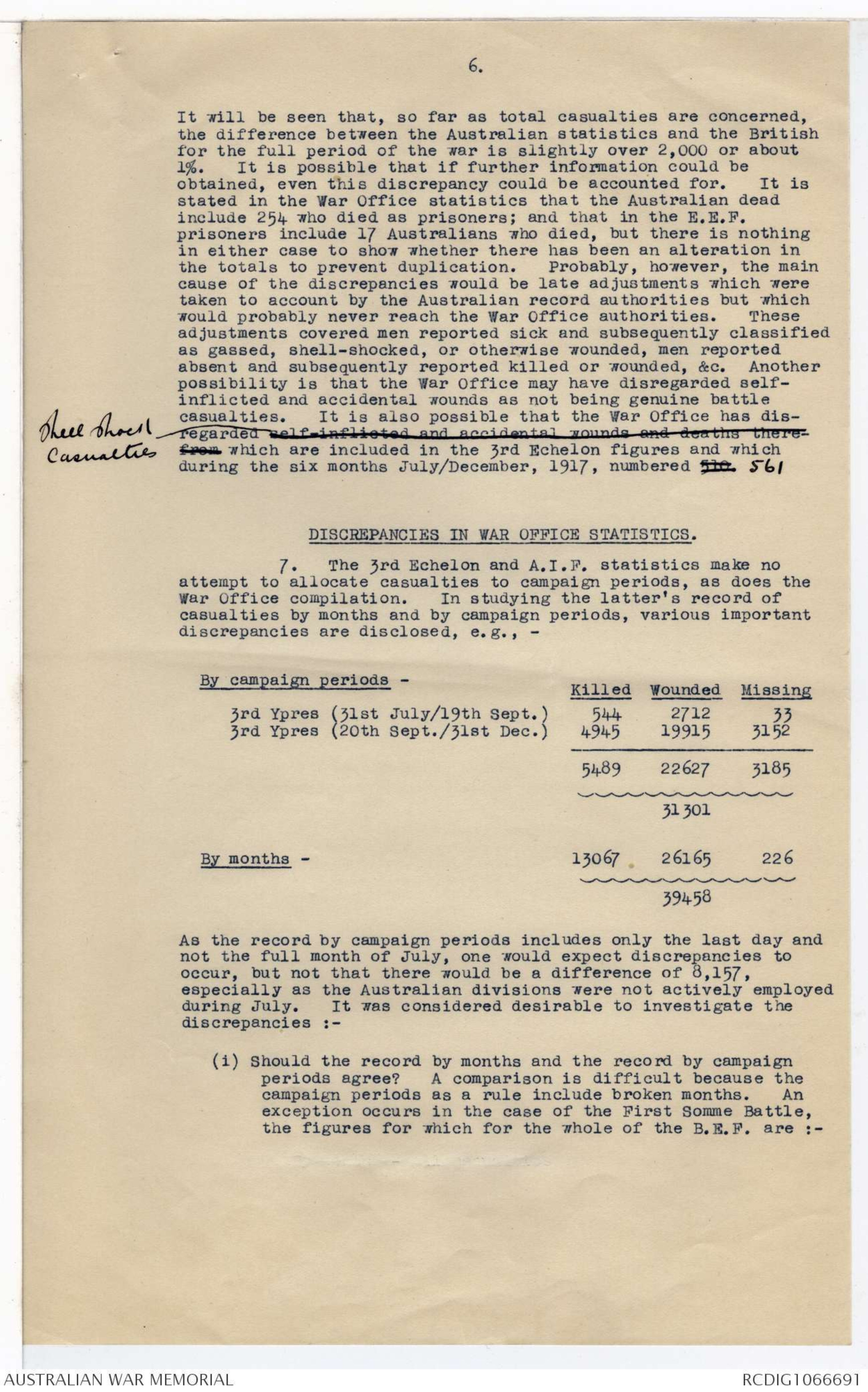
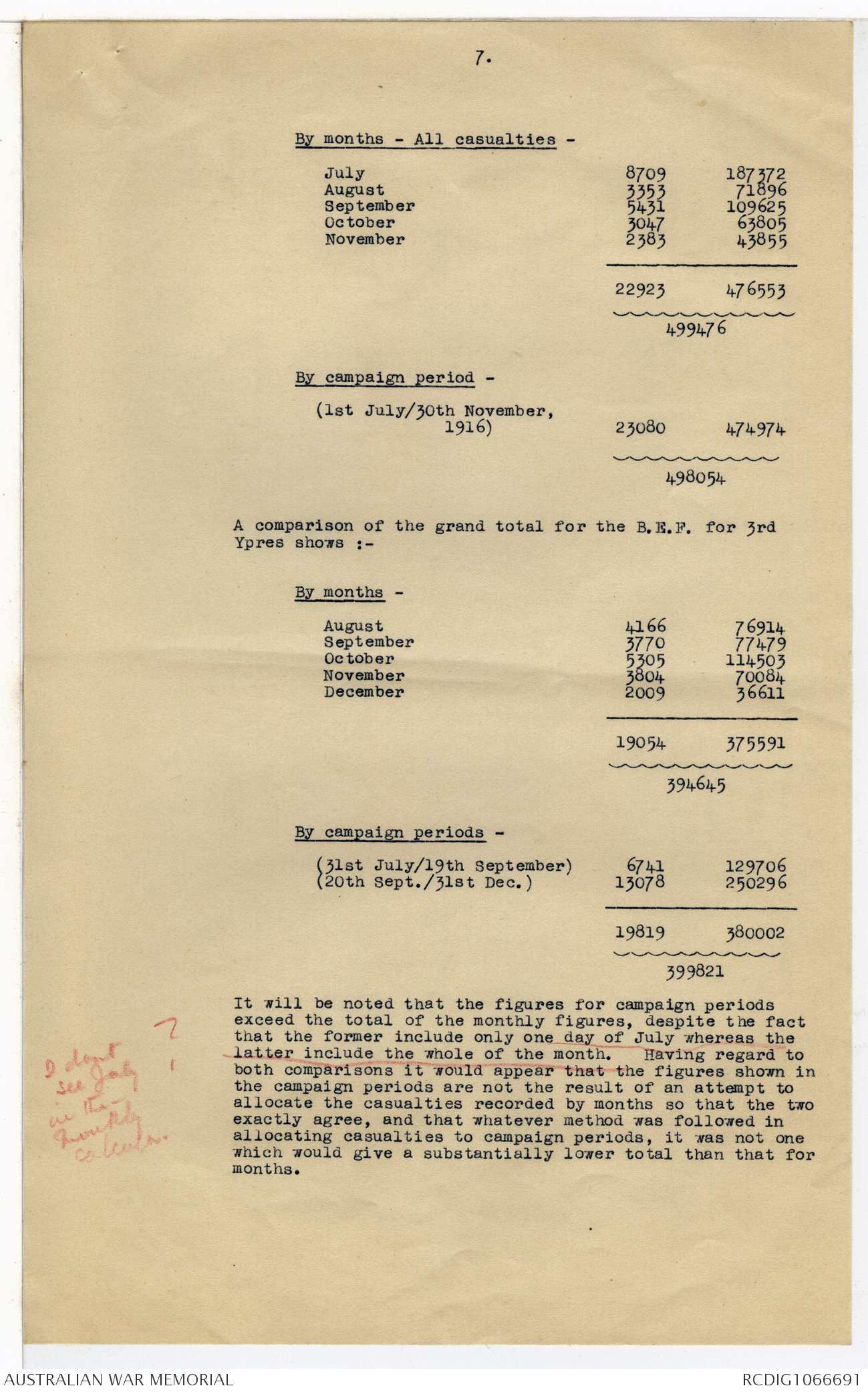
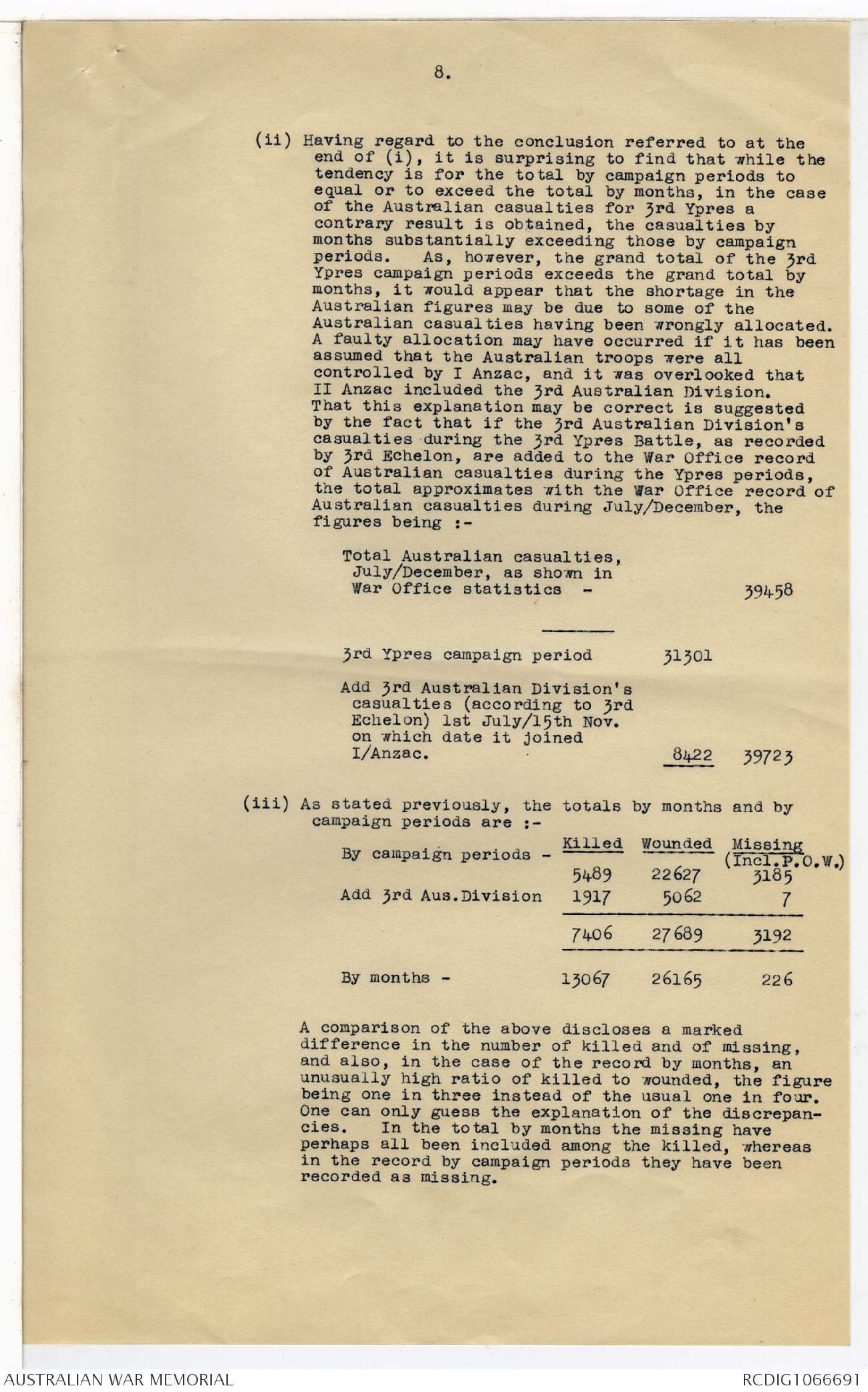
TELEPHONE NOS.
F 2597
F 2598
COMMUNICATIONS TO BE ADDRESSED TO
"THE DIRECTOR"
IN REPLY PLEASE QUOTE
NO..............................................
COMMONWEALTH OF AUSTRALIA.
"They gave their lives. For that public gift they
received a praise which never ages and a
tomb most glorious - not so much the tomb in
which they lie, but that in which their fame
survives, to be remembered for ever when occasion
comes for word or deed....."
TELEGRAPHIC ADDRESS
"AUSWARMUSE."
AUSTRALIAN WAR MEMORIAL.
POST OFFICE BOX 214 D.
EXHIBITION BUILDINGS, MELBOURNE.
15th March, 1933
Dear Dr. Bean,
Having spent some time studying the available records
of the casualties at Ypres, and having noticed how they vary, I
am quite prepared to prove the accuracy of any figure which you
care to adopt!
Having studied the problem in some detail, I have
embodied the result in a report which I am forwarding herewith.
I trust that you will not be bored by its length. I would not
have dealt with the matter in such detail if it were not that it
seemed to me it might be helpful for you at the present juncture
to decide to accept some authority and to adhere to it in future.
You will note from the report that I have come to the
conclusion that the Australian 3rd Echelon statistics ought to be
accepted as the most reliable record of Australian casualties in
France. Notwithstanding the jocular remark contained in the
first paragraph of this letter, the Australian record does not
vary widely from the British monthly record and, by making a
certain assumption, it can be reconciled with the British campaign
period figures. Colonel Butler is apparently satisfied that he
can accept the 3rd Echelon figures, and if you also accept them
it will help to ensure that the Medical History and the Official
History agree.
Personally, I admit that I at times felt that the work
of the record staff was not reliable but, looking back, I am not
sure that that feeling was not purely prejudice. The record
staff may have included some "duds", but it also included a number
of efficient officers and other ranks. Its statistical section
was responsible for compiling figures on which important financial
transactions were based, and I cannot imagine that steps were not
taken to ensure that its work was carried out efficiently and
accurately.
In addition to the report, I am sending herewith two
specimen pages from one of the books in which the 3rd Echelon
statistics were recorded, the extracts made by Withers for 3rd
Ypres and for Pozieres, and also the papers relating to casualties
which I took from your office. The specimen pages will be
of interest in that they show the manner in which the statistical
information was recorded, and also bear evidence of the
Dr. C. E. W. Bean,
Official Historian,
Victoria Barracks,
PADDINGTON, N.S.W.
-2 -
corrections made to adjust alterations in the classification of
casualties, thus confirming that steps were taken to avoid
duplication. The Pozieres figures were taken out because I know
that you will be interested to see how they compare with the 3rd
[*Returned*] Ypres casualties. It would help Withers if his extracts were
returned, and I shall be grateful if you will do this as soon as
convenient.
It appeared to Heyes and me to be worth while to attempt
to account for the discrepancies between the Australian figures
and other records which you had. Being unaware of the manner in
which the latter were compiled, attempts to account for discrepancies
resolved themselves into pure conjectures. While these
are, as a rule, borne out by the application of the figures in
accordance with the conjectures, one cannot be sure that the
result is anything more than coincidence.
Yours sincerely,
[[J Treloar?]]
AUSTRALIAN CASUALTIES DURING THE
THIRD BATTLE OF YPRES.
THE AVAILABLE RECORDS.
1. There are three statistical records which purport to
show the casualties sustained by the A.I.F. These are:-
(a) Record compiled by the Statistical Section of the
Australian Branch of G.H.Q., 3rd Echelon. (3rd
Echelon Statistics.)
(b) "Australian Imperial Force Statistics of
Casualties, etc., compiled to 30th June, 1919"
issued by Records Section, A.I.F. Headquarters,
London. (Horseferry Road Statistics.)
(c) "Statistics of the Military Effort of the British
Empire during the Great War, 1914-1920" issued
by the War Office. (War Office Statistics.)
3rd ECHELON STATISTICS.
The 3rd Echelon statistics were compiled from day to
day while the A.I.F. was in France, and exist today in a number of
large books - one for each division and for corps troops - in the
custody of the Base Records Office. The statistics were compiled
by a special section, the staff of which is stated to have been
efficient. The section was responsible for the compilation of the
strength returns on which the financial settlements between
Australia and Great Britain took place, and it may be assumed that
steps were taken to ensure that their work was carried out carefully.
The statistics compiled by the section were based on Part
II Orders, which in turn were made up from field returns submitted
weekly by units and from hospital reports. The hospital reports
had to be taken into consideration as, for example, men frequently
became casualties before they had joined or while they were absent
from their units, which were not therefore in a position to report
them. Part II Orders were made up under a number of prescribed
headings which appear to have been devised to avoid duplication.
Separate headings provided for particulars of men who had
previously been reported under one category and were later transferred
to another, e.g., from "Wounded" to "Died of wounds".
Under the various headings the names of men appeared with the dates
of their casualties. They were counted in the Statistical Branch
and transferred to the books referred to above. Entries in the
books were made by days, officers being kept separate from other
ranks, and the books being divided into sections to provide for
the recording of different categories of casualties. When a
correction occurred, an alteration was made in the statistical
record. The pro forma of a weekly casualty return compiled by
3rd Echelon bears a footnote reading "Care must be taken that the
same men are not shown under the heading "Died of wounds" and
"Wounded", thus proving that 3rd Echelon were alive to the need to
avoid duplication. Specimen pages which have been examined
confirm that corrections were made. Having regard to the
circumstances in which this record was compiled, no grounds on
which it might be faulted have suggested themselves. On the
2.
contrary, it would appear that it must be accepted as reliable.
Its one possible weakness appears to be that it was based on
records submitted by units and hospitals in France, and therefore
probably did not take cognisance of what occurred outside that
country, so that if a man wounded in France subsequently died
while in England, he would have been recorded by 3rd Echelon as
"wounded" and not "died of wounds".
HORSEFERRY ROAD STATISTICS.
3. The "A.I.F. Statistics of Casualties, etc." is a
printed record issued by A.I.F. Headquarters. The disposal of
the original records and the method of compiling the statistics
are unknown. They were presumably based on the same data as
the statistics compiled by 3rd Echelon, and in addition the
reports sent in by hospitals in England. It may be expected
therefore that these statistics would furnish totals different
from those given by the 3rd Echelon Statistical Section, but the
discrepancy ought not to be substantial. A defect in the
A.I.F. Headquarters' statistics is that they were not published
by months, and it is therefore impracticable to make use of them
in determining casualties for a period of the fighting on the
Western Front. There is, however, in existence a typewritten
statement, dated 8th January, 1919, submitted by Lieut.-Colonel
C.T. Griffiths, A.A.G. at A.I.F. Headquarters, London, to the
Department of Defence, showing wastage and casualties in the
A.I.F., B.E.F., for the period 1st January, 1917, to 11th
November, 1918. This would presumably be taken from the same
source as the printed statistics issued by A.I.F. Headquarters.
WAR OFFICE STATISTICS.
The "Statistics of the Military Effort of the
British Empire" contains a record of casualties in the B.E.F.
by months and by campaign periods. These figures differ from
the two Australian records and it must be assumed that they were
compiled independently. The War Office statistics include
extracts from "A.I.F. Statistics" in a section dealing with the
military effort of Australia but a note is appended "For estimate
of casualties by C.2, Cas., W.O., see p.239" which supports the
inference that the War Office record of casualties by months and
campaign periods is an independent compilation. The War Office
publication contains nothing to indicate on what the casualty
statistics were based, and it is significant that the casualties
statistics are stated to be approximate. It was thought
improbable that they were or could have been based on returns
submitted by battalions and other units, but, instead, must
have been based on returns by divisions, corps, or even armies
submitted by G.H.Q. to the War Office, and therefore on approximate
figures and not on reports supported by names and
corrected from time to time, as in the case of the Australian
records. This was however tested and disproved by comparing
the casualties for July/August, 1917, with the 3rd Echelon
figures for the 3rd and 4th Divisions when it was found
3.
necessary to add the 3rd Echelon figures for divisional
artilleries and other detached units and miscellaneous units to
get a total which would approximate to the British figures.
The entries relating to Australia in the War Office statistics
were submitted to the Australian Government before the volume
was published, and were referred to the Australian War Museum.
The Director pointed out that, as the information was largely
statistical, and the statistical records of the A.I.F. were in
the custody of the Officer-in-charge Base Records, the War
Museum was not in a position to check these sections. Attention
was, however, drawn to certain apparent discrepancies, e.g.,
the allocation of 18,632 Australian casualties to the Cambrai
campaign period. The draft was also perused by the Officer-in-
charge Base Records, who commented on a few of the totals but
was unable to make anything in the nature of a thorough check.
When the draft was returned to the British Government it was
stated by Defence that it had been checked by the War Museum,
but no reference was made to the War Museum's criticism, thus
implying that the War Museum confirmed the British figures.
The published work agrees with the draft submitted to Australia
except that the Australian figures for the Cambrai period have
been altered, the British authorities having apparently noticed
this discrepancy before publication.
AN ASSUMPTION CORRECTED.
5. When the question of the A.I.F. casualties at
Ypres was discussed with Dr. Bean on the lst March, it was
understood that he had obtained from the A.I.F. statistics a
record, by month, of A.I.F. casualties which gave a total of
38,452. As this total practically agreed with a certain total
obtained from the War Office monthly statistics, it was thought
that the latter must have been taken from the former, and could
not therefore be regarded as corroboration of the Australian
figures. At the time of the preparation of this report the
only particulars available of the figures obtained by Dr. Bean
from the A.I.F. statistics are a column of figures which appears
in the left-hand column below. Opposite have been placed the
figures extracted from the war Office monthly statistics :-
4.
| 39) | 39) | ) | ||
| 713) | 748) | Total deaths | ) | |
| 2) | 1) | ) | ||
| 48) | 36) | Missing and prisoners | ) | July |
| 113) | 104) | ) | ||
| 2478) | 2214) | Wounded | ) | |
| 23) | 25) | ) | ||
| 421) | 547) | Total deaths | ) | |
| 1) | -) | ) | ||
| 10) | 8) | Missing and prisoners | ) | August |
| 68) | 63) | ) | ||
| 1410) | 1345) | Wounded | ) | |
| 152) | 169) | ) | ||
| 3110) | 3261) | Total deaths | ) | |
| 4) | 5) | ) | ||
| 22) | 18) | Missing and prisoners | ) | September |
| 335) | 376) | ) | ||
| 9367) | 7108) | Wounded | ) | |
| 284) | 309) | ) | ||
| 5397) | 6405) | Total deaths | ) | |
| 2) | 14) | ) | ||
| 92) | 118) | Missing and prisoners | ) | October |
| 550) | 525) | ) | ||
| 13811) | 12671) | Wounded | ) | |
| 51) | ) | |||
| 1047) | Total deaths | ) | ||
| -) | ) | |||
| 17) | Missing and prisoners | ) | November | |
| 64) | ) | |||
| 1154) | Wounded | ) | ||
| 38452 | 38442 |
(It will be seen that, although the totals are almost the
same, they are based on different details and periods.)
5.
Comparison of the three records.
6. (a) As stated above, the War Office statistics
furnish a record of casualties by theatres of war, by months, and
by campaign periods. The 3rd Echelon statistics were compiled
by days, and are limited to France. The Horseferry Road
statistics in the printed form available to this office furnish
totals for units, arms, and theatres of war, while the typed
statement furnishes monthly figures for France from 1st January,
1917, to the end of the war. The differing forms restrict the
comparisons which can be made. It is, however, practicable to
compare the figures given by each for the period 1st July/3lst
December, 1917. For this period the Australian casualties
(deaths from all causes, wounded, missing (including prisoners))
being:-
| Month |
3rd Echelon |
Horseferry Road |
War Office |
||||||
| July Aug. Sept. Oct. Nov. Dec. |
D. |
W. |
P.O.W. |
D. |
W. |
M & P.O.W. |
D. |
W. |
M. |
|
751 |
2594 |
49 |
735 |
2597 |
51 |
787 |
2318 |
37 |
|
|
11076 |
30937 |
205 |
10961 | 31035 | 212 | 13067 | 26164 | 226 | |
|
42, 218 |
42,208 |
39, 458 |
|||||||
(b) The above table shows that the Horseferry Road and
3rd Echelon statistics, although differing in detail, roughly
agree so far as the grand total is concerned. The monthly totals
in the War Office statistics are about 2,760 lower. The 3rd
Echelon statistics were based on a daily allocation of casualties,
while the War Office were probably allocated according to the
date of returns with the result that casualties at the end of one
month may have been allocated to the next month. There is
therefore room for variations in a short period which would
disappear if the full period of the war were taken. On this
basis the following comparison is afforded :-
|
Horseferry Road |
War Office |
|||||||
B.E.F. E.E.F. M.E.F. U.K. |
Deaths. |
W. |
P.O.W. |
T. |
Deaths. |
W. |
M. (incl. P.O.W. |
T. |
|
46319 |
130919 |
3861 |
181099 |
46078 |
129971 |
3083 |
179132 |
|
[*∅This is the correct total. In the
book the total casualties are
incorrectly shown as 1023 officers,
25071 other ranks, instead of 1033
officers, 25609 other ranks. *]
6.
It will be seen that, so far as total casualties are concerned,
the difference between the Australian statistics and the British
for the full period of the war is slightly over 2,000 or about 1%.
It is possible that if further information could be
obtained, even this discrepancy could be accounted for. It is
stated in the War Office statistics that the Australian dead
include 254 who died as prisoners; and that in the E.E.F
prisoners include 17 Australians who died, but there is nothing
in either case to show whether there has been an alteration in
the totals to prevent duplication. Probably, however, the main
cause of the discrepancies would be late adjustments which were
taken to account by the Australian record authorities but which
would probably never reach the War Office authorities. These
adjustments covered men reported sick and subsequently classified
as gassed, shell-shocked, or otherwise wounded, men reported
absent and subsequently reported killed or wounded, &c. Another
possibility is that the War Office may have disregarded self-inflicted
and accidental wounds as not being genuine battle
casualties. It is also possible that the War Office has disregarded
shell-shocked casualties self-inflicted and accidental wounds and deaths therefrom
which are included in the 3rd Echelon figures and which
during the six months July/December, 1917, numbered 510 561
DISCREPANCIES IN WAR OFFICE STATISTICS.
7. The 3rd Echelon and A.I.F. statistics make no
attempt to allocate casualties to campaign periods, as does the
War Office compilation. In studying the latter's record of
casualties by months and by campaign periods, various important
discrepancies are disclosed, e.g.,
By campaign periods -
|
Killed |
Wounded |
Missing |
|
| 3rd Ypres (31st July/19th Sept.) |
544 |
2712 |
33 |
| 3rd Ypres (20th Sept./31st Dec.) |
4945 |
19915 |
3152 |
|
5489 |
22627 |
3185 |
|
|
|
31301 |
|
|
| By months - |
13067 |
26165 |
226 |
|
|
39458 |
|
As the record by campaign periods includes only the last day and
not the full month of July, one would expect discrepancies to
occur, but not that there would be a difference of 8,157
especially as the Australian divisions were not actively employed
during July. It was considered desirable to investigate the
discrepancies :-
(i) Should the record by months and the record by campaign
periods agree? A comparison is difficult because the
campaign periods as a rule include broken months. An
exception occurs in the case of the First Somme Battle,
the figures for which for the whole of the B.E.F. are :-
7.
| By months - All casualties - | ||
| July | 8709 | 187372 |
| August | 3353 | 71896 |
| September | 5431 | 109625 |
| October | 3047 | 63805 |
| November | 2383 | 43855 |
| 22923 | 476553 | |
|
499476 |
||
| By campaign period - | ||
| (1st July / 30th November, 1916) |
23080 | 474974 |
|
498054 |
||
A comparison of the grand total for the B.E.F. for 3rd
Ypres shows:-
| By months - | ||
| August | 4166 | 76914 |
| September | 3770 | 77479 |
| October | 5305 | 114503 |
| November | 3804 | 70084 |
| December | 2009 | 36611 |
| 19054 | 375591 | |
|
394645 |
||
| By campaign periods - | ||
| (31st July/19th September) | 6741 | 129706 |
| (20th Sept./31st Dec.) | 13078 | 250296 |
| 19819 | 380002 | |
|
399821 |
||
It will be noted that the figures for campaign periods
exceed the total of the monthly figures, despite the fact
that the former include only one day of July whereas the
[*I dont see July in the monthly calculation?*]
latter include the whole of the month. Having regard to
both comparisons it would appear that the figures shown in
the campaign periods are not the result of an attempt to
allocate the casualties recorded by months so that the two
exactly agree, and that whatever method was followed in
allocating casualties to campaign periods, it was not one
which would give a substantially lower total than that for
months.
.
(ii) Having regard to the conclusion referred to at the
end of (i), it is surprising to find that while the
tendency is for the total by campaign periods to
equal or to exceed the total by months, in the case
of the Australian casualties for 3rd Ypres a
contrary result is obtained, the casualties by
months substantially exceeding those by campaign
periods. As, however, the grand total of the 3rd
Ypres campaign periods exceeds the grand total by
months, it would appear that the shortage in the
Australian figures may be due to some of the
Australian casualties having been wrongly allocated.
A faulty allocation may have occurred if it has been
assumed that the Australian troops were all
controlled by I Anzac, and it was overlooked that
II Anzac included the 3rd Australian Division.
That this explanation may be correct is suggested
by the fact that if the 3rd Australian Division's
casualties during the 3rd Ypres Battle, as recorded
by 3rd Echelon, are added to the War Office record
of Australian casualties during the Ypres periods
the total approximates with the War Office record of
Australian casualties during July/December, the
figures being:-
Total Australian casualties
July/December, as shown in
War Office statistics - 39458
------------
3rd Ypres campaign period 31301
Add 3rd Australian Division's
casualties (according to 3rd
Echelon) 1st July/15th Nov.
on which date it joined
I/Anzac. 8422 39723
(iii) As stated previously, the totals by months and by
campaign periods are :-
| By campaign periods - | Killed | Wounded | Missing (Incl. P.O.W.) |
|
5489 |
22627 |
3185 |
|
| Add 3rd Aus Division |
1917 |
5062 |
7 |
|
7406 |
27689 |
3192 |
|
| By months - |
13067 |
26165 |
226 |
A comparison of the above discloses a marked
difference in the number of killed and of missing,
and also, in the case of the record by months, an
unusually high ratio of killed to wounded, the figure
being one in three instead of the usual one in four.
One can only guess the explanation of the discrepancies.
In the total by months the missing have
perhaps all been included among the killed, whereas
in the record by campaign periods they have been
recorded as missing.
 Sam scott
Sam scottThis transcription item is now locked to you for editing. To release the lock either Save your changes or Cancel.
This lock will be automatically released after 60 minutes of inactivity.